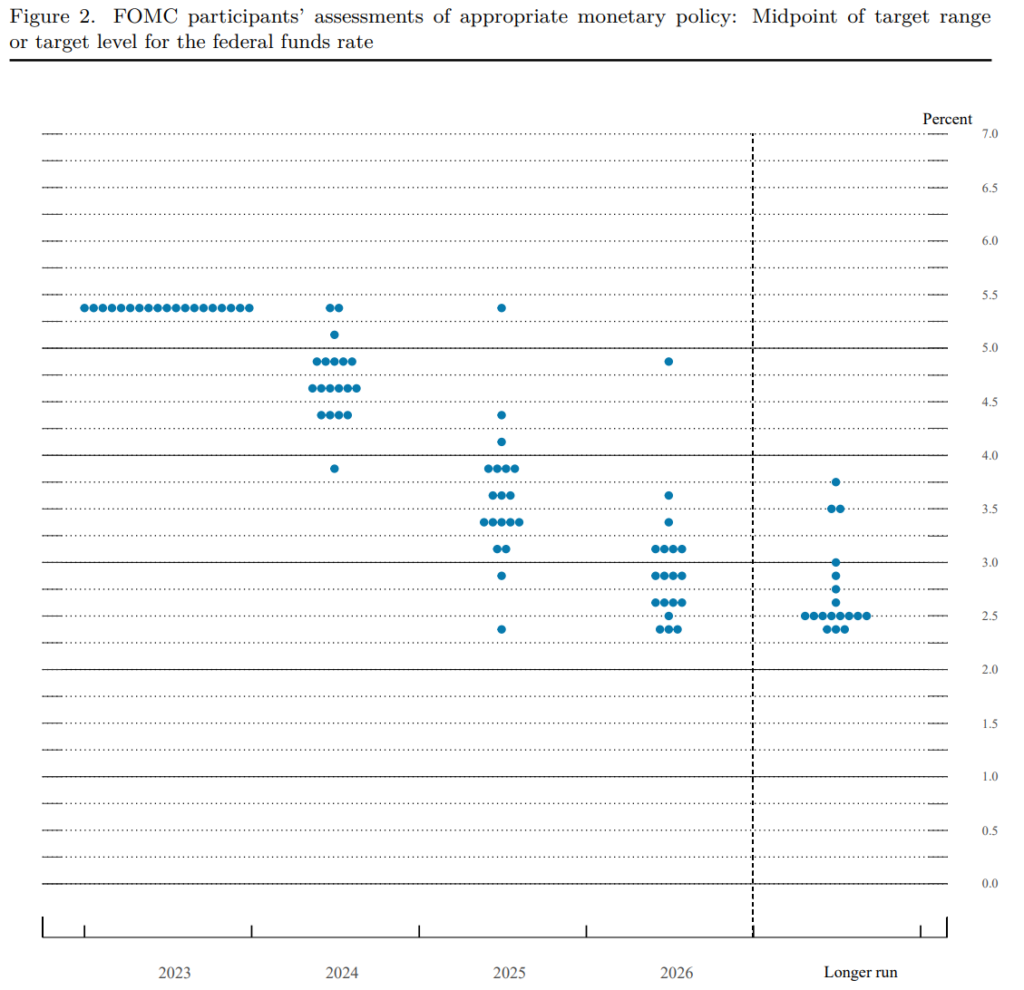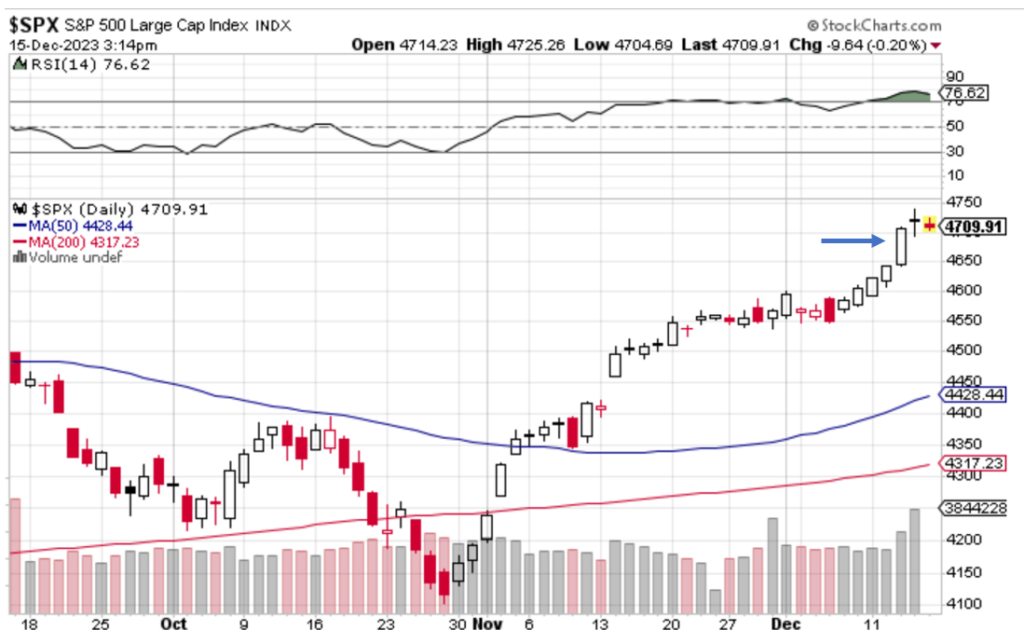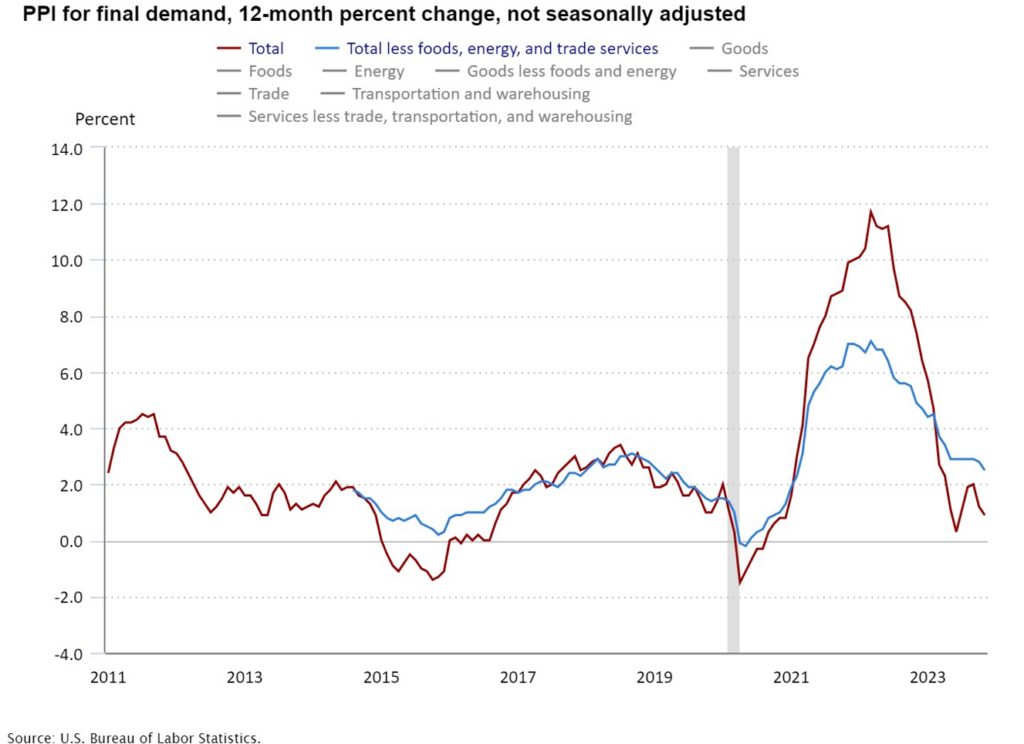When investing, I know it can be tough to remain patient. Media headlines of doom or boom, with market swings of big drawdowns or huge rallies can make even the most experienced investors frazzled, let alone those without much day-to-day investment experience.
My belief has been that at some point, inflation would come down from high levels the Fed would stop raising interest rates and would start to cut rates. This would be the end of the rate hiking cycle. The anticipation of these factors could cause equity markets to rally, and that’s what happened the last couple of days. Really, the last couple of days have been an extension of the rally that started in early November, after the quick selloff in October and investors became nervous.
If you as an equity investor were patient for these developments to occur, and either ignored the market volatility the last couple of years or tactically took advantage of the market dips, you would have been rewarded.
Fed Indicates Rate Cuts Next Year
Based on the latest projections of the Federal Open Market Committee, members forecast the fed funds rate target to be roughly 4.6% by the end of 2024, a decent decline from the current fed funds rate target of 5.25-5.5%. Based on the data below, the FOMC is anticipating rate cuts for the next couple of years.

Source: FOMC Summary of Economic Projections, December 13, 2023. Additional data retrieved from https://www.federalreserve.gov/monetarypolicy/fomcprojtabl20231213.htm, December 15, 2023.
Equity Markets Rally
What did the equity market do after the news was released on December 13th? It rallied hard. Here is a look at the S&P 500 Index over the last couple of months. You can see the nice rally since the late October bottom.

Source: StockCharts.com 12/15/23
The Dow Jones Industrial Average also rallied to new all-time highs. So patient investors in a passive DJIA passive index strategy could have just closed their eyes, not looked at their statements and ignored the short-term volatility the last 2 years, and would have more money today than they did at the prior peak of the index at the start of 2022.

Source: StockCharts.com 12/15/23
Taking a step back a bit on the S&P 500 Index (usually paid more attention to by investors than the Dow), the chat below shows the S&P 500 Index is now approaching its previous highs and up over 30% from its October 2022 lows. A quick reminder, as an investor, is it better to add risk assets when everyone is freaking out (October 2022) or now when potentially, the “coast is clear” in the minds of others now that the Fed has signaled rate cuts next year? I don’t know about you, but a 30% rally from October 2022 when markets continued to decline from 2021 highs appears more attractive than selling at those levels due to fear, or another worse strategy, waiting until now to buy back into the market when things “feel” better.

Source: StockCharts.com 12/15/23
In my post on November 20, 2023, I indicated that investors may continue to push the equity markets higher, as year end seasonality can often provide a bullish tailwind. Well, in addition to this potential seasonal tailwind, the Fed gave risk assets a boost when it formally indicated potentially three rate cuts next year.
Why is the Fed anticipating rate cuts? Because inflation continues to show deceleration. If the Fed is anticipating inflation to continue to come down from elevated levels of the last couple of years to a more “normal” range of 2-3%, a fed funds rate of 5%+ no longer makes sense.
So, if investors anticipate inflation to decline, interest rates to decline and we can avoid a deeper economic slowdown, lower interest rates and costs can potentially boost company profits and consumers/businesses can keep more money in their pockets to spend. If there is more spending, there is more profits and stock prices and other risk assets can move higher. For the last month or so, this reasoning and what I have been stating for awhile, equity markets and other risk assets can move higher.
Quick Look at Inflation
If we look at the recent Producer Price Index (PPI), which helps to provide insights into inflationary pressures for manufacturers/industry, you can clearly see a downward trajectory from the highs in 2021 and 2022. So my thought that inflation would come down over time, appears to be correct. PPI is often considered a leading indicator for the economy, so if this holds other inflation-related data (Consumer Price Index, etc.) could continue to show deceleration as we move forward.

Source: U.S. Bureau of Labor Statistics. Retrieved from https://www.bls.gov/charts/producer-price-index/final-demand-12-month-percent-change.htm, December 15, 2023.
Remember: Markets are Forward Looking
So again, if a year ago it was anticipated that inflation would come down from elevated highs, resulting in the Fed to cut the fed funds rate at some point, which is often bullish for risk assets, then it would have been appropriate to add to risk assets when inflation was higher, and interest rates were higher and prices of risk assets were lower. Buy Low.
Taking a look at the S&P 500 Index again, when was a buy point when inflation was high and fear of higher interest rates impacted investors? It was later in 2022 and the first few months of this year. Then after the initial rally through mid-year, and increased fear of higher interest rates hit the market in October, when the 10-year Treasury yield breached 5%, adding risk there, even through simple rebalancing, would have made sense, as I indicated in my November note. Investors following that thought process would have been rewarded.
So as it shows, as of the scariest of times in October 2022, investors may have been adding risk in anticipation of inflation coming down, interest rates coming down, and an economy that may be able to continue to muddle through into and through next year. As an investor, if you looked forward in October 2022 rather than being nervous at the time after the selloff and added to risk assets, you’d be thanking yourself now.

Source: StockCharts.com, December 15, 2023
Looking Forward
Well, hopefully you’ve participated in the recent equity market rally. So now what?
A pullback following this recent strong rally (again, that has been in anticipation of better inflation news and seasonal bullishness), should not be a surprise. For longer-term investors, a tactical rebalance (sell high) in areas that have rallied and/or that are above target allocations could be a suitable action to take at this time.
If investors are anticipating lower interest rates next year with the economy avoiding a material slowdown, investors may shift to areas of the equity markets that have lagged and valuations remain attractive, including in small caps, mid caps and international equities. Broad diversification in higher quality companies in these areas should be considered if not already exposed there.
As always, anticipate volatility and figure out what you would do if markets reach certain levels for you to take action. If you are an investor, buying low and selling high is a strategy to consider.
A quick word on “selling high”. Now, for me selling high does not mean selling everything and going to 100% cash or something. It just means rebalancing or trimming back to target allocations if your exposure gets out of your long-term target allocations. If you’re trying to sell a top, you’re becoming a trader. If the markets continue to move higher and your negative emotions start kicking in again, negative consequences of making emotional decisions become a material concern. Have a pre-thought out strategy instead. Don’t let your emotions take over.
